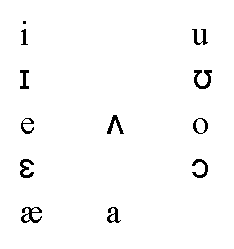
Blackfoot is an Algonquian language spoken by about 5000 people of the Blood, Peigan, and Siksika tribes in southern Alberta and Northern Montana. It's closest sister within the Algonquian family is Cree. Geographically, Blackfoot has the most contact with English. The data was collected from Deanna Starlight, a female in her early forties who was raised on the Siksika reserve.
The accent system in Blackfoot is unclear. Mostly it seems to be stress, however at times, it seems that there are tonal qualities.
The language is currently in a period of rapid change between what it's speakers classify
as "Old Blackfoot" and "New Blackfoot"; dialects spoken by older and younger generations
respectively. It is to this latter categorization that our informant belongs. Comparisons have
drawn between the two dialects, using The Blackfoot Dictionary of Stems, Roots and Affixes
by D.G. Frantz and N.J. Russell as a conservative form of Blackfoot.

There are no voiced non-sonorant consonants in Blackfoot nor are there any liquids. Stops are
not aspirated but they are released (except those marked). Length is contrastive.

Phonemically, in Blackfoot, there are only three vowels /i/, /o/, and /a/. However, an inventory of
eleven tense and lax allophones of those three phonemes is evident. Vowel length is contrastive,
although, with one exception illustrated below, only tense vowels have length. Vowels may also
be voiceless in certain environments that will be discussed in section 5.3. Voicelessness is marked
on the vowel regardless of whether it is only partial or complete voicelessness.
Campbell, George L. 1991. Compendium of the World's Languages. New York: Routledge Press. 210-213.
Frantz, D.G. 1978. Abstractness of Phonology and Blackfoot Orthography Design. In McCormack et al (eds), 307-326.
Frantz, D.G. 1989. Blackfoot Dictionary of Stems, Roots, and Affixes. Toronto: University of Toronto Press.
Frantz, D.G. 1991. Blackfoot Grammar. Toronto: University of Toronto Press
McCormack, William C., and Wurm, Stephen A. (eds.) 1978. Approaches to Language. Chicago: Mouton Publishers.